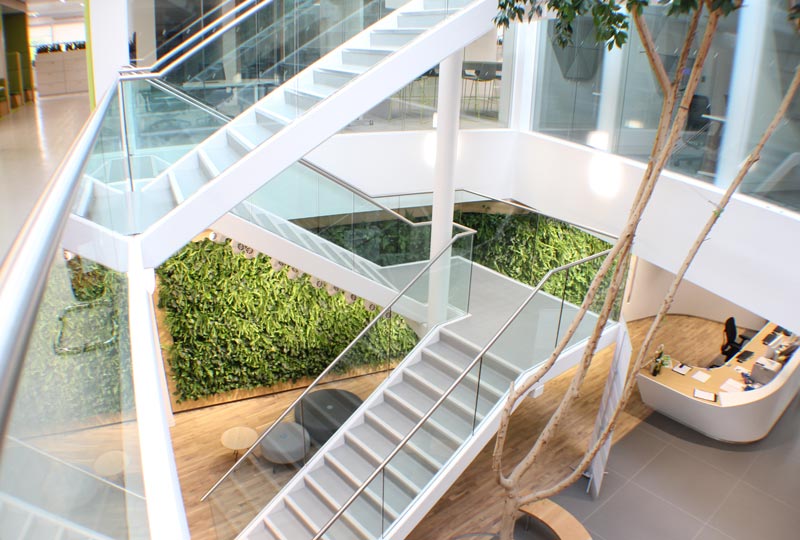What is Biophilic Design?

 Read time: 6mins
Read time: 6mins- Share
- Biophilic design features natural light, fresh air, greenery and natural forms
- It’s becoming increasingly popular and prominent in the working environment
- Thought to improve the health and wellbeing of building’s occupants
- Facebook, Apple and Amazon all incorporate Biophillic Design into their offices
If you’ve ever walked into a workplace with no windows and harsh fluorescent lighting, you’ll know how draining it feels. On the flip side, stepping into a space with natural light, fresh air, and greenery can instantly lift your mood.
That’s the idea behind biophilic design, creating buildings and interiors that connect people with nature. It’s more than a style choice. Done well, it improves wellbeing, supports productivity, and makes spaces people actually want to spend time in.
It’s no surprise that forward-thinking companies like Apple, Amazon, and Facebook have invested heavily in biophilic workplaces to keep their teams engaged, creative, and happy.
Where did the idea come from?
The term biophilia was first used in the 1960s to describe humankind’s innate love of nature. It gained traction in the 1980s when biologist Edward O. Wilson published his book Biophilia, sparking decades of research into how our environments affect our health and behaviour.
Fast forward to today, and that research has collided with architecture and interior design to create what we now call biophilic design, nature-inspired spaces that are good for both people and the planet.
What makes a design biophilic?
Biophilic design isn’t just about “adding some plants.” It’s about creating a deeper sense of connection to nature. That can include:
- Natural light filling rooms and reducing reliance on artificial lighting
- Fresh air and ventilation for healthier, more comfortable spaces
- Natural materials like wood, stone, and bamboo that feel warm and authentic
- Views of greenery or water from windows and communal areas
- Living walls and planting schemes that bring vibrancy indoors
- Spaces for respite that encourage relaxation and focus
- Forms and patterns inspired by nature, from flowing lines to organic textures
In short: if a building makes you feel closer to nature, calmer, more focused, more at ease, it probably has elements of biophilic design.
Why does it matter?
Research has shown clear links between our surroundings and our health. Poor light, lack of ventilation, and windowless rooms can contribute to stress, fatigue, and even long-term health issues.
By contrast, biophilic environments have been shown to:
- Reduce stress and anxiety
- Improve concentration and cognitive function
- Support creativity and problem-solving
- Encourage faster recovery in healthcare settings
- Increase productivity and employee satisfaction in workplaces
It’s why healthcare providers, educational institutions, and major employers are all weaving biophilic elements into their buildings.
What biophilic design is not
Not every space with a plant in the corner counts as biophilic. True biophilic design places nature at its core.
Planting a tree in a courtyard or putting flowers in reception may brighten the space, but it’s not the same as designing a building around natural principles.
Biophilic design is intentional, holistic, and designed to change how people experience a space — not just how it looks.
Who’s using biophilic design?
Some of the world’s biggest innovators are already leading the way.
- Apple Park in Cupertino was designed as a biophilic “campus in a forest,” with thousands of trees, walking paths, and abundant natural light.
- Amazon’s Spheres in Seattle provide employees with indoor gardens housing 40,000 plants.
- Healthcare providers are investing in patient rooms with views of nature, proven to reduce recovery times and increase satisfaction.
It’s not only the giants, though. Businesses of all sizes are realising that investing in healthier environments pays off in engagement, retention, and brand reputation.
What’s next for biophilic design?
Biophilic design is only becoming more important. Expect to see:
- Smart biophilic buildings that use sensors and IoT to adjust light, air, and even water features to support occupants’ wellbeing.
- Retrofits and interiors bringing green walls, planting schemes, and natural materials into existing spaces.
- Mainstream adoption as employees, customers, and clients increasingly expect healthier, greener environments.
Next steps: bring nature into your workplace 🌿
The evidence is clear: we thrive when our spaces connect us to nature. Biophilic design isn’t a passing trend. It’s becoming essential for businesses that want happier teams, healthier workplaces, and more inspiring environments.
At Inleaf, we help companies achieve this through living walls, planting schemes, and bespoke biophilic installations that transform spaces.
At Inleaf, we specialise in helping businesses improve their workplace with office plants and living walls.
Got a project in mind? Get in touch today and let’s explore how we can bring the benefits of biophilic design into your workplace.
Next Steps...
Got a project in mind?
We’re here to help.
Fill in the form below and one of our team will get in touch.


